Pounds, shillings and pence calculators
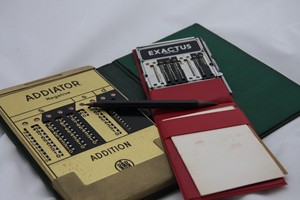
Were there any old money or pounds, shillings and pence calculators? How did people add up their shopping if they didn't want to do it in their heads or with a pencil and paper?
Japanese and American companies introduced the world to pocket electronic calculators in 1971. That was the same the year that Britain switched to decimal currency. So there were no pounds, shillings and pence pocket calculators. But there were mechanical devices which could do sums in pounds shillings and pence. Some fitted into a pocket.
Super Add-a-Matic (c1962)

If you wanted to add up your shopping in the 1960s you needed a 'Super Add-A-Matic'. The original one was made in Japan.
It added up small amounts in pounds, shillings and pence. So if you wanted to check your till receipt it was ideal. You could carry it around in your pocket or handbag.
It must have been hard to get accurate results. Pushing one of the buttons only added one pound, one shilling or one penny. You had to push each button several times to enter a number, for example, to add 3 shillings and 5 pence to the total, push the shilling button three times and the pence button five times. After several prices like 2/11, 5/11 or 7/6 it was easy to lose count and have to start again!
There were also Add-A-Matics for the American market. They added up in dollars, dimes and pennies. They were advertised in 1962 in The New York Times for a dollar each. Sears also sold Add-A-Matics for 59c each or two for $1 in 1964.
Later versions of the Add-A-Matic were made in Hong Kong.
In the US there were several competitors which did the same thing:
- Quick Adder (Hong Kong)
- Handy Adder (Hong Kong)
- Handy Counter
- Pocket Adder
- Auto Add
- Add-It (Japan)
- Automatic Adder
- Adi Mini Adder (Hong Kong)
- Shopper Adder
The Shopper Adder could do subtraction as well.
When decimal currency came along in 1971, the UK Add-A-Matic became the Decimal Adder.
All types sold until the mid-1970s when electronic pocket calculators became much cheaper.
Addiator and Exactus
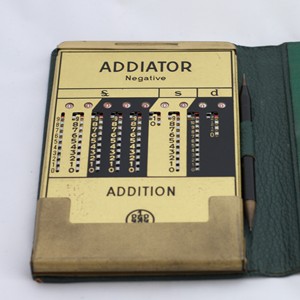
The Addiator and Exactus were both mechanical calculators made from metal plates. You moved the digits with a stylus. They handled the carry forward for addition and subtraction. With a bit of practice, they were easy to master.
The Addiator was manufactured by Addiator Gesellschaft in Germany. The design is from the beginning of the twentieth century. It is a variation on the original model which did addition and subtraction in base 10.[1]
The Addiator could handle sums up to £10,000. This would be enough for most people in the 1960s. They cost 59s 6d (or £2 19s 6d) in 1965. In today's money that would have been £42.

The Exactus was pocket sized. It is the closest thing you can get to a pounds, shillings and pence pocket calculator. You could choose from black, blue, grey or red wallets. There was a metric version as well as the sterling version for the same price.
In the 1950s an Exactus cost 26 shillings, or about £22 in today's money.
Slide rules
Before electronic calculators, people used slide rules for multiplication and division. A slide rule has logarithmic scales and does multiplication by addition and subtraction on a logarithmic scale.
They were the preferred calculating devices for mathematicians, engineers and scientists. But there were very few slide rules that coped with pounds shillings and pence.
Faber and Castell Super Business
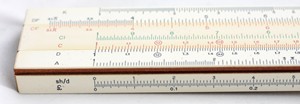
Faber and Castell was the Rolls Royce of slide rule makers. The German firm made some of the best quality slide rules. They made just one that could do £sd.
Only it didn't. It had a scale that converted decimal to shillings and pence. You converted to decimal, did the calculation and converted back.
Unique Monetary
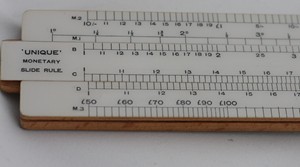
It was left to a British company to make the only true £sd slide rule. The Unique Monetary had its logarithmic scales marked in pounds, shillings and pence.
Adding machines and comptometers
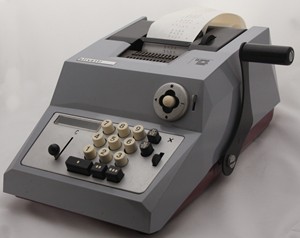
For the office and the small business there were mechanical and electro-mechanical adding machines. They could add and subtract in pounds shillings and pence. Ones made before 1960 needed to deal with farthings as well as pennies and halfpennies.
For serious adding up you needed a comptometer. From the 1950s to the 1980s accounting firms employed comptometer operators. When I worked as an accountant in the 1980s, I remembered a retired member of staff who came in especially from time to time when there was a serious amount of adding up to do. She brought her own machine which was a veteran of the pounds, shillings and pence era. It was converted to decimal in 1971.
Computers
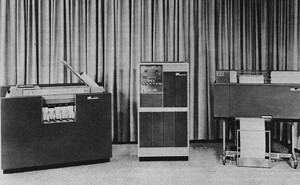
Gobierno de los Estados Unidos, Public domain, via Wikimedia Commons
Didn't we have computers in the 1960s? How did they cope with pounds, shillings and pence?
Computers did not naturally work with pounds, shillings and pence. Complicated financial calculations were made more complex by the sterling currency system. This was one of the reasons for adopting decimal currency.
Main frame computers of the 1950s and 1960s were used by banks and large companies. They needed to be able to handle the UK currency. Both the IBM 1401 and the IBM 360 had programs that added and subtracted figures in pounds, shillings and pence.
Read more
- Virtual pounds, shillings and pence calculator
- Decimal converters and calculators
- 1970s pocket calculators
References
[1] 'Centuries of Inventions: Encyclopedia and History of Inventions' by Jorge Lucendo, published by Jorge Lucendo in 2020


Comments